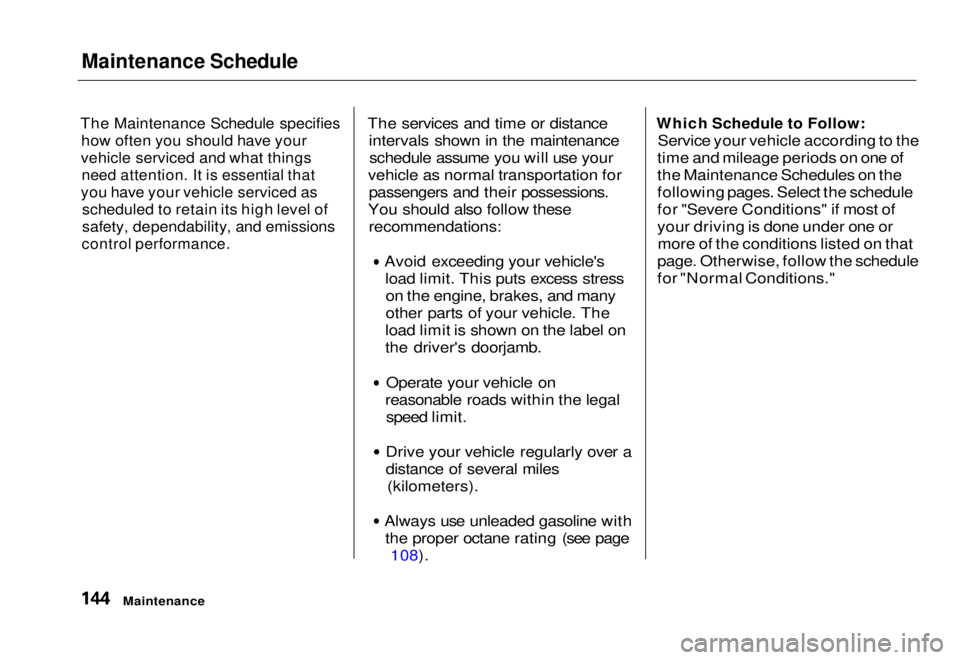Page 145 of 251

Maintenance Schedule
The Maintenance Schedule specifies how often you should have your
vehicle serviced and what things
need attention. It is essential that
you have your vehicle serviced as scheduled to retain its high level of
safety, dependability, and emissions
control performance.
The services and time or distance
intervals shown in the maintenanceschedule assume you will use your
vehicle as normal transportation for passengers and their possessions.
You should also follow these
recommendations:
Avoid exceeding your vehicle'sload limit. This puts excess stresson the engine, brakes, and many
other parts of your vehicle. The
load limit is shown on the label on
the driver's doorjamb.
Operate your vehicle on
reasonable roads within the legal speed limit.
Drive your vehicle regularly over a
distance of several miles (kilometers). Always use unleaded gasoline with
the proper octane rating (see page
108).
Which Schedule to Follow:
Service your vehicle according to the
time and mileage periods on one of
the Maintenance Schedules on the
following pages. Select the schedule
for "Severe Conditions" if most of
your driving is done under one or more of the conditions listed on that
page. Otherwise, follow the schedule
for "Normal Conditions."
MaintenanceMain Menu Table of Contents s t
Page 148 of 251
Maintenance Schedule for Normal Conditions (listed by distance/time)
Service at the indicated distance or time, whichever comes first. Do the items in A, B, C as required for each distance/time interval. Follow this
schedule if
the severe driving conditions described in the Severe Conditions Schedule on the next page do not apply.
Canadian owners: Follow the schedule for Severe Conditions.
Maintenance
page 178
page 165
# : See info on maintenance and emissions warranty, last column,
page 145.
* : See Timing Belt on page 178 to determine need for replacement.Main Menu Table of Contents s t
Page 157 of 251

Engine Oil
The oil container may also display the API Certification mark. Makesure it says "For Gasoline Engines." The SAE numbers tell you the oil's
viscosity or weight. Select the oil foryour vehicle according to this chart.
An oil with a viscosity of 5W-30 is preferred for improved fuel economyand year-round protection in your
Honda. You may use a 10W-30 oil if
the temperature in your area never
goes below 20°F (-7°C). Synthetic Oil
You may use a synthetic motor oil if it meets the same requirements
given for conventional motor oil; energy conserving, a service
classification of SJ, and the proper
weight as shown on the chart. When using synthetic oil, you must follow
the oil and filter change intervals
given in the maintenance schedule.
Additives
Your Honda does not need any oiladditives. Purchasing additives for
the engine or transmission will not
increase your vehicle's performanceor longevity. It only increases the
cost of operating your vehicle.
Maintenance API CERTIFICATION MARK
Ambient TemperatureMain Menu Table of Contents s t